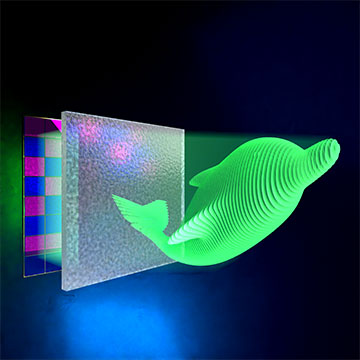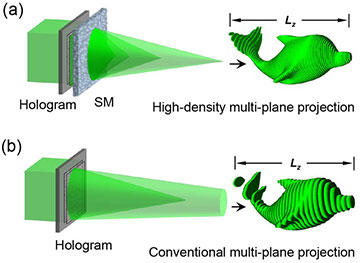
Researchers have developed a new way to achieve dynamic projection of 3D objects onto ultrahigh-density successive planes. [Image: L. Gong, University of Science and Technology of China]
The more details that fit into a 3D holographic image, the more “real” it will look for virtual-reality applications. Scientists in China and Singapore have described a new approach to holography that boosts depth resolution by up to three orders of magnitude (Optica, doi: 10.1364/OPTICA.483057). The method, called three-dimensional scattering-assisted dynamic holography, or 3D-SDH, uses a diffuser that dramatically reduces the amount of spacing between image planes and also suppresses crosstalk between them.
How 3D holography works
Computer-generated holography employs a spatial-light modulator (SLM) or a digital micromirror device (DMD) to project encoded information. However, today’s SLMs have small diffraction angles and low pixel counts that limit their depth control. In addition, there’s a lot of crosstalk between the projected image planes, which drags down the resolution of the final image.
“Our new method overcomes two long-existing bottlenecks in current digital holographic techniques—low axial resolution and high interplane crosstalk—that prevent fine depth control of the hologram and thus limit the quality of the 3D display,” says Lei Gong, an optics professor at the University of Science and Technology of China (USTC) and the corresponding author of the study.
The 3D-SDH setup devised by researchers at USTC and the National University of Singapore employs a DMD with 768 × 768 pixels, focusing lenses, a pinhole and a thin layer of zinc-oxide nanoparticles as a scattering medium. A 562-nm-wavelength laser generated the light for the experiment.
As shown at the top, the new 3D scattering-assisted dynamic holography approach creates a digital hologram by projecting high-resolution images onto planes spaced closely together, achieving a more realistic representation than conventional holography techniques, shown at the bottom. “SM” indicates scattering medium. [Image: L. Gong, University of Science and Technology of China] [Enlarge image]
The team had previously performed simulations of holographic projections based on a point-cloud model of a rocket. The 3D-SDH model projected 125 successive image planes with a depth interval of 0.96 mm, whereas the model that used a more conventional holographic technique produced only 32 on-axis images at intervals of 3.75 mm.
Future challenges
“Our current 3D holograms reconstructed only point-cloud 3D images, but they can be viewed from any direction over the full 4π solid angle,” Gong says. The team’s ultimate goal is to create 3D solid-body holograms, but that would require SLM or DMD technology with many more pixels, as well as new algorithms, probably employing machine-learning methods. “In addition, a judiciously designed scattering medium is required, instead of measuring the large 3D transmission matrix of the medium,” he notes.
In terms of future uses, “Our method might benefit real-life applications such as virtual reality, 3D printing, optical encryption and more,” Gong adds. “For virtual reality, our method could be used with headset-based holographic displays to greatly improve the viewing angles, which would enhance the 3D viewing experience. It could also provide better 3D visuals without requiring a headset.”


